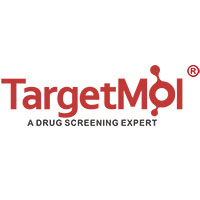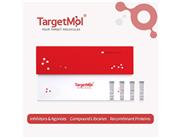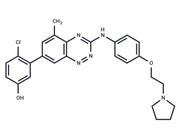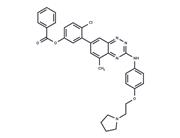| Name | TG 100572 Hydrochloride |
| Description | TG 100572 Hydrochloride is a inhibitor of multi-targeted kinase which inhibits receptor tyrosine kinases and Src kinases(IC50s of 2, 7, 2, 16, 13, 5, 0.5, 6, 0.1, 0.4, 1, 0.2 nM for VEGFR1, VEGFR2, FGFR1, FGFR2, PDGFRβ, Fgr, Fyn, Hck, Lck, Lyn, Src, Yes, respectively). |
| In vitro | apoptosis in rapidly proliferating, but not quiescent, endothelial cell cultures induced by TG 100572[1]. TG 100572 is shown to inhibit hRMVEC cell proliferation(IC50 of 610±72 nM). TG 100572 has the therapeutic potential to inhibit VEGF function in ocular endothelial cells, a contributing factor to pathological angiogenesis in diseases such as AMD and PDR[2]. |
| In vivo | Systemic delivery of TG 100572 in a murine model of laser-induced choroidal neovascularization (CNV) significantly suppresses CNV, but is associated with weight loss indicative of systemic toxicity[1]. TG 100572 (23.4 μM) reaches the choroid and sclera within 30 minutes (Tmax = 0.5 h), with relatively low levels in the retina. Due to its short half-life in ocular tissues, TG 100572 is administered topically at least t.i.d. to maintain appropriate eye levels. The maximum concentration achievable in formulations is 0.7% w/v[2]. |
| Storage | Powder: -20°C for 3 years | In solvent: -80°C for 1 year | Shipping with blue ice. |
| Solubility Information | DMSO : 20 mg/mL (39.03 mM), Sonication is recommended.
|
| Keywords | Vascular endothelial growth factor receptor | FGFR | TG100572 | PDGFR | Inhibitor | TG 100572 | VEGFR | Platelet-derived growth factor receptor | inhibit | TG 100572 Hydrochloride | Fibroblast growth factor receptor | TG-100572 | TG100572 Hydrochloride | TG-100572 Hydrochloride | Src |
| Inhibitors Related | Ribociclib | Amlexanox | Nintedanib | Regorafenib monohydrate | Sorafenib | Ferulic Acid | Regorafenib | Sorafenib tosylate | Formononetin | Imatinib | Pazopanib | Axitinib |

 United States
United States



